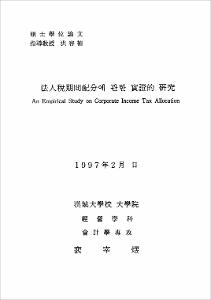法人稅期間配分에 관한 實證的 硏究
= (An) Empirical Study on Corporate Income Tax Allocation
- Files in This Item:
-
-
Download
 000000066404.pdf
기타 데이터 / 1.87 MB / Adobe PDF
000000066404.pdf
기타 데이터 / 1.87 MB / Adobe PDF
-
Items in Repository are protected by copyright, with all rights reserved, unless otherwise indicated.